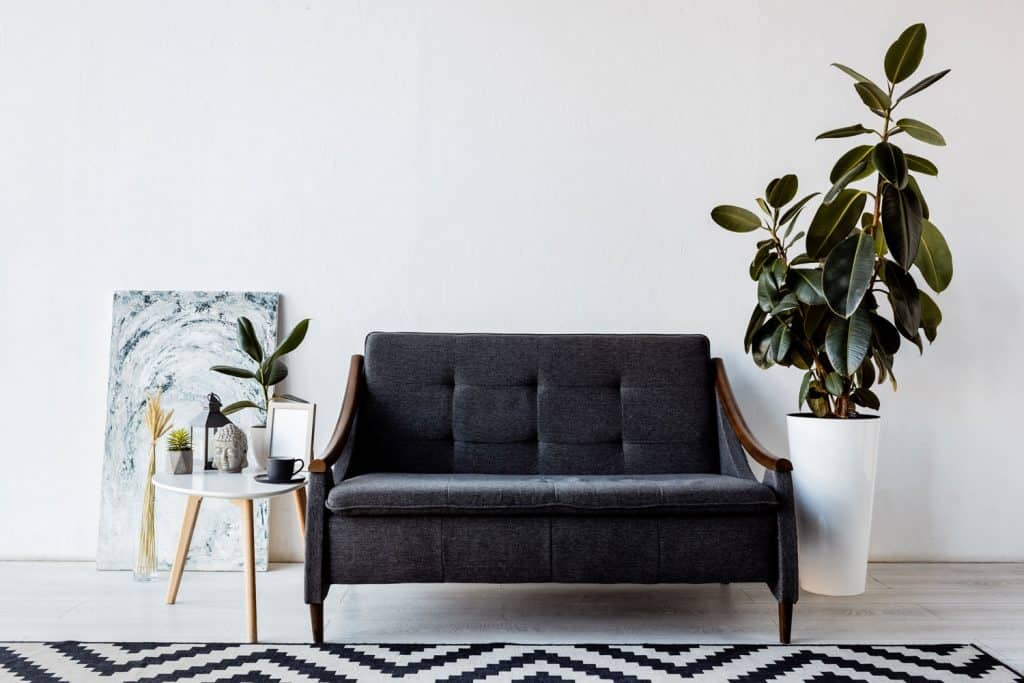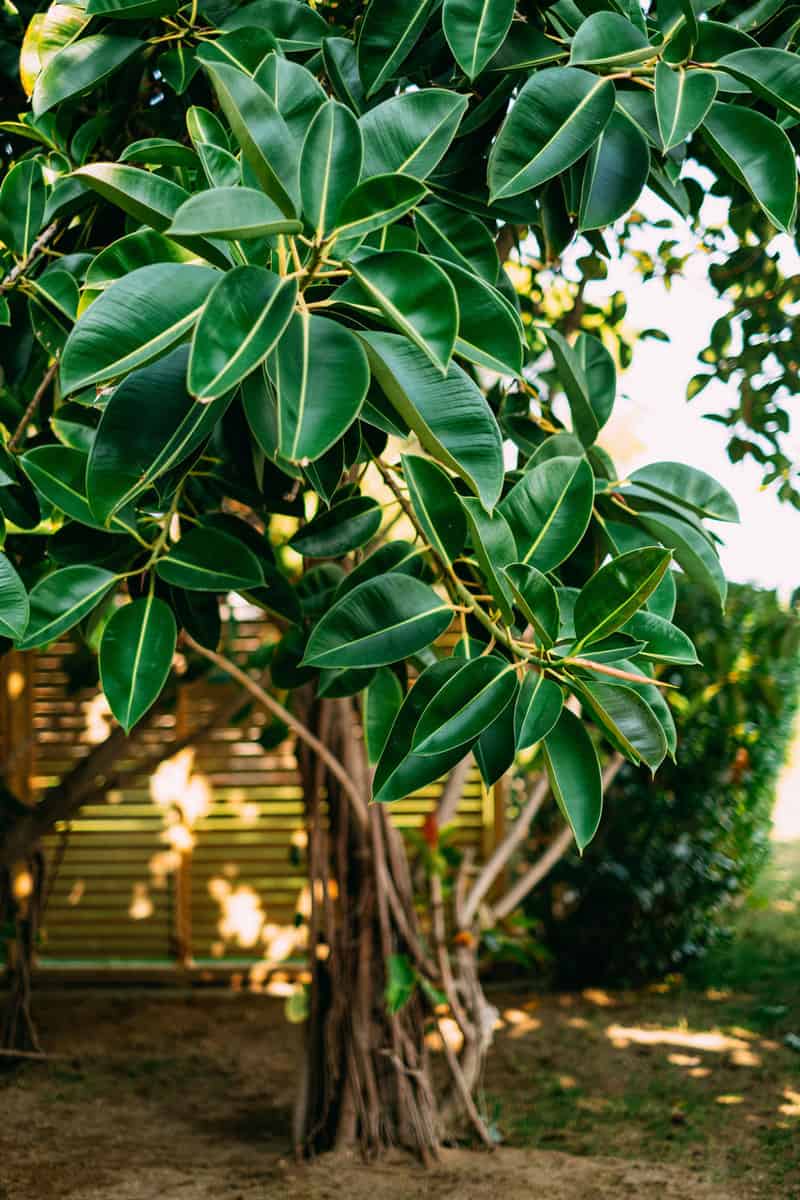The rubber tree is a popular house plant that many people find easy to grow and maintain. However, if you have just purchased a rubber plant or are considering buying one for your home, you may be curious about how fast it may grow. In this post, we will go over the growth rate of rubber trees as both indoor plants and outdoor plants, and we'll also cover ideal conditions for promoting their growth.
Indoor-grown rubber plants tend to grow anywhere from 4 to 10 feet tall. However, in their native environment, they are known to grow up to 100 feet tall.
Read on to learn more about the growth rates of rubber trees.
![Woman putting on gardening gloves to start planting her rubber plant, How Big Does A Rubber Tree Get [Indoors And Outside]](https://gardentabs.com/wp-content/uploads/2020/12/How-Big-Does-A-Rubber-Tree-Get-Indoors-And-Outside.png)
Promoting growth with ideal conditions

Most rubber trees are grown in Asia. However, Africa, South, and Central America are also regions where many rubber trees are grown. Rubber trees thrive in areas where the climate is hot, moist, and receives a good amount of sunlight. When in their native climate and left to grow on their own, rubber trees typically grow about two to three feet per year. However, domesticated rubber plants may grow at a slower pace of one to three feet per year.
Sunlight
Rubber trees prefer conditions that have a lot of sunlight, but not necessarily direct sunlight. It's best not to place the tree in a room with low lighting as it will struggle to survive and may begin to experience health issues or stunted growth. The best lighting for rubber trees is a few hours of filtered light from a bright light source every day.
Consider exposing rubber plants to sunlight in the morning before the sun reaches its strongest point at high noon. Also, be sure not to expose the plant to direct sunlight as it may burn the leaves. It may also be a good idea to purchase white or light-colored blinds to help filter some of the sun's rays if your home receives a lot of direct sunlight.
Water
Rubber trees prefer a decent amount of water; however, too much water will make their leaves droop. It's important to keep the soil in their pots moist. But be sure that it does not stay submerged in water for long periods of time. In the wintertime, the trees will require even less water. It's best to water the soil when the top two to three inches of it become dry. The great thing about rubber trees is that they will quickly let you know when they receive too much water or not enough water.
Check out this watering can on Amazon!
Temperature
The ideal temperature range for these trees is fairly broad, as they can thrive in temperatures ranging from 55 degrees to 85 degrees Fahrenheit. Temperatures higher than 85 degrees will result in the plant's leaves becoming more withered and dry. And while the rubber tree can also survive a quick bounce of lower temperatures, anything lower than 50 degrees Fahrenheit would put the tree at risk for developing various plant diseases and even dying out if left too long.
Wild rubber trees can tolerate a good range of climate conditions and changes, though they thrive best when kept at consistent conditions. They may experience plant shock if exposed to new conditions too quickly. It's best not to move the planet to different conditions too often, as they may start to show signs of stress when acclimating to a new environment. Keeping a hygrometer near it can help you monitor temperature and humidity settings.
Check out this hygrometer on Amazon!
Humidity
When it comes to humidity, rubber trees prefer conditions where there is a considerable amount of humidity, but at the same time, they aren't that picky. Relative humidity of anywhere from 40% to 60% is ideal. If you notice that the leaves of the tree look less plump or dry all of a sudden, it may be a good idea to give them a quick mist of water to moisturize them. Unless you live in a climate with exceptionally low humidity levels, it will typically be the least of your worries when growing a rubber tree.
Pruning & Propagation
Pruning is one of the most popular subjects when it comes to growing a rubber plant indoors. It's important to help your tree continue to grow healthy and strong. Rubber trees are known for their ability to grow really tall, even indoors. So if you are looking for your tree to stay short and bushy, you will need to prune it accordingly. Rubber plants can be pruned at any time; however, the best time to prune them would be in the warmer months of the year--especially if you will make major changes to the plant.
Check out these gardening shears on Amazon!
A Quick Note on Rubber Tree Sap: Rubber plant does contain sap, which is toxic to humans and animals. It's known to cause skin irritation as well as gastrointestinal issues if accidentally ingested. It can also cause eye and mouth irritation as well. The toxicity level is classified as a "Level 4," meaning that it's the highest level of toxicity that a plant can have.
For this reason, it is strongly recommended that you use protective gloves when trimming your tree, as well as keep parents and children away from it, particularly after pruning. If you do find that you come in direct contact with the sap, be sure to wash it off your skin as soon as possible.
Check out these rubber gloves on Amazon!
Repotting
Young rubber plants will need to be re-potted whenever the roots become what's known as "pot-bound." This occurs when a plant's roots form a dense and tangled mass inside of their container, allowing for little space for additional growth. Rubber plants will typically require a new pot every year. Re-potting the rubber plant is fairly simple, as you'll simply need to gently remove the plant from one pot and place it into another that has a few extra inches for the roots to grow.
Check out this pot set on Amazon!
Fertilizer
While fertilizer isn't necessarily required for a rubber plant to grow, it can be essential in helping your plant grow large glossy leaves. It can also help promote a steady or fast rate of growth. The rubber tree is open to various feeding schedules and fertilized every few weeks or on a monthly schedule during the warmer months (winter seasons won't see much growth). If the plant has just been re-potted, it typically won't need any fertilizer for the first few months, as the new soil will give the planned all of the nutrients that it needs.
Check out this fertilizer on Amazon!
Common Pests
Like any other type of indoor or outdoor plant, a rubber plant can be subject to various types of diseases and pests, which can threaten their vitality and growth rates.
Spider mites are probably the most common pests on all indoor plants. You can usually detect them by looking for any white webs on the undersides of your plant's leaves. They can be eradicated by rubbing the leaves with alcohol or spraying them with soapy water.
Root-knot nematodes can slowly eat away at your rubber tree plant if they are not eradicated. Prevention is probably the best way to defeat this particular pest. These soil-based pests can be eradicated by simply heating your soil for a few minutes.
Scale bugs another common enemy of the rubber plant. They can be removed using alcohol, neem oil, or rinsing the plant off with water.
Check out this neem oil on Amazon!
Plant Stress Signs
Leaves Dropping
As with other indoor plants, it's normal for your rubber plant to occasionally shed leaves as new one's sprout. However, if you notice that your tree is losing more leaves than it is growing, this could be a sign that it is experiencing distress. One of the most common causes of dropping leaves for rubber tree plants is over-watering. If you find that this is the case, you'll need to re-pot your plant and limit your watering sessions for the next few weeks so that the plant can restore itself. Watering the plants once a week should suffice until it gets healthier.
Another common reason for dropping leaves is plant shock due to a lack of light or drafty temperatures. It's important to ensure that your rubber plant gets a sufficient amount of light each day and is never kept in an environment that's less than 50 degrees Fahrenheit for a prolonged period of time.
Yellowing Foliage
The leaves of a rubber tree may turn yellow if the plant is under-watered or lacking essential nutrients. Typically, establishing a better water schedule and supplying the plant with a good fertilizer can mitigate this issue. Overwatering can also cause the leaves to turn yellow. If this is the case, consider falling back on your watering schedule and reduce it to once a week.
How fast do rubber trees grow?

The rubber tree is a fast-growing plant species, which normally grows about two feet or more each year. Outdoor rubber plants tend to grow faster than indoor rubber plants, and they typically reach their mature height after 13 years. Indoor plants, however, will typically grow at a slower speed and max out at about 13 feet.
Are rubber trees bushy?
Rubber trees are naturally tall and skinny plants. However, with regular pruning, they can easily grow as bushy shrubs with a wide span of at least five feet. To make the plant bushier, it will need to be pruned once or twice a year, as it produces two additional branches from every trimmed branch.
Can you trim (or prune) a rubber tree?
You can absolutely trim a rubber tree plant. This is actually one of the keys to making the plant appear bushier. If you prefer your rubber tree plant to appear more thin and leggy, you shouldn't prune it.
How do you make a rubber tree grow tall?
The key to making an indoor plant grow taller is to re-pot when it becomes root-bound. As the roots of the plant grow longer and thicker, so will the plant's bark. Small pots will restrict the growth of rubber plants, keeping them smaller.
How big of a pot does a rubber tree need?
Typically rubber plants need a pot that's no bigger than 1/3 bigger than the plant's root base.
Wrapping Things Up
![Woman putting on gardening gloves to start planting her rubber plant, How Big Does A Rubber Tree Get [Indoors And Outside]](https://gardentabs.com/wp-content/uploads/2020/12/Woman-putting-on-gardening-gloves-to-start-planting-her-rubber-plant-1024x683.jpg)
Establishing the best growth conditions for your rubber plant can ensure that it will continue to thrive and grow at an impressive rate.
Before you go, be sure to check out our other posts:







